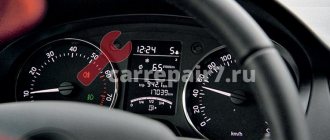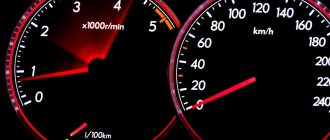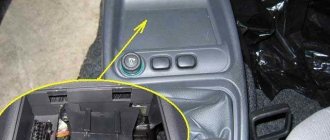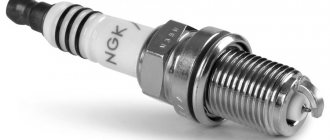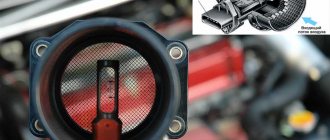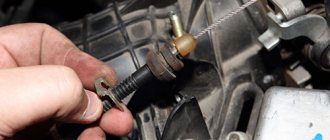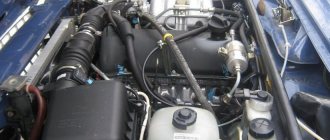Large cash costs for fuel are a natural problem for every car enthusiast. Having a car greatly affects the family budget at current prices for different types of fuel. It is known that gas equipment is installed on a car to save on gasoline and diesel fuel, the price of which is growing all the time.
Saving on gas
Gas consumption is more profitable compared to gasoline. However, having installed gas equipment, it is unlikely that you will be able to forget about fuel costs; you still need to monitor your gas consumption. There are many factors that can cause gas and gasoline consumption to increase. Often, increased gas or gasoline consumption can cause a significant blow to your funds. If you see that gas consumption has increased, this does not always depend on a malfunction of the gas equipment; the presence of this problem is also possible in other cases.
General factors influencing the increase in consumption of different types of fuel
First you need to pay attention to the quality of the engine. Various dysfunctions of the driving force can lead to increased fuel consumption. Additional equipment may also be the cause. Another common factor: poor driving habits. For example, fuel consumption will increase if there is a high speed when driving. Some typical problems that lead to increased fuel consumption:
- malfunction of the on-board computer;
- filter contamination;
- pressure surges in the fuel system;
- failure of the automatic transmission;
- malfunction of the auto radiator system, respectively - lack of engine cooling;
- incorrect injector program.
It is recommended to undergo technical inspection in a timely manner so as not to rack your brains later about why excessive fuel consumption occurs.
How to fix the problem
It is better to pay special attention to reducing the increased gas consumption of 4th generation gas equipment. The reasons that led to this malfunction not only force you to spend more money on fuel for your car, but also make it less safe.
Gas leaks, clogged injectors, wear of the gearbox, and other problems in the operation of the LPG system will ultimately lead to serious problems that will create an emergency situation on the road. The consequences will be severe. But this can be avoided if defects are eliminated in time. The first step towards this should be regular technical inspection of the gas equipment. It is recommended to undergo it at least once a year and only in specialized installation and service centers.
They reduce gas consumption for 4th generation LPG in different ways. Depending on the root cause, repairs may be required, including the replacement of some parts of the vehicle or reconfiguration of the electronic control system. You shouldn't do this on your own. HBO is a thin and sensitive system.
Contact specialists for help today. Our experienced staff will eliminate the cause of your high gas consumption, allowing you to start saving money on fuel again.
Malfunction of the ESU and injection system
The processes occurring in the engine operation of many modern cars are controlled by special sensors. They are connected directly to the ECS (electrical control system), so fuel consumption and other things are regulated. Failures in the electrical system and sensor errors affect the composition of the fuel mixture. The composition of the mixture may become lean or oversaturated. In one case or another, the driving force of the car loses power, and accordingly, fuel consumption increases. As a result, it is necessary to diagnose the operation of the temperature sensor for any problems. The fuel supply system (injector) is one of the main devices on which the correct operation of the engine depends. It is necessary to keep the injector clean, remove the accumulation of soot and dirt regularly and sometimes diagnose it for prevention. The use of dirty injection nozzles affects the atomization of the mixture; part of the mixture burns in the manifold or catalyst, which leads to their damage. Poor quality production of this device directly affects the drop in the vehicle’s acceleration level; there is a load on the gearbox, which also affects the increase in fuel costs.
Poor fuel pressure and automatic transmission malfunction
The loss of fuel is caused by increased pressure, at which the fuel mixture is enriched with an additional volume of fuel. But this happens extremely rarely. Too low pressure has a greater impact on fuel consumption. At the same time, the productivity of the internal combustion engine noticeably decreases, the acceleration dynamics of the car weakens, and the ECS does not have time to compensate for the lack of fuel in a certain period of time. Reasons for low pressure include wear of the fuel pump strainer, fuel filter, or the fuel pump itself when using low-quality gasoline. The first sign of an automatic transmission malfunction is an uncharacteristic sound from the engine, which indicates overload, followed by an increase in fuel consumption. In this case, you should stop further operation of the transmission, which leads to fuel consumption, and contact a service center. By the way, the consumption of an automatic transmission is usually 1.5 liters higher compared to a manual transmission. Availability of car air conditioning. If you have air conditioning, if the consumption of gasoline or other fuel increases only in the summer, then this is normal. Engine operating parameters partly affect the energy consumption of the air conditioner. When driving around the city, about 20% of fuel consumption comes from the air conditioner, and when driving on the highway, the percentage of air conditioning costs is almost unnoticeable.
Effect of engine overheating on fuel consumption
The stability of fuel consumption depends on the acceptable temperature in the engine system. At elevated temperatures, the fuel-air mixture ratio is disrupted, as the fuel quickly evaporates in the intake manifold. The stability of engine parameters is lost and power is significantly reduced. The ECU sensors receive an incorrect signal, and the fuel system pressure decreases, which leads to excessive fuel consumption.
Reasons for overheating of the engine device:
- Unacceptable position and operation of the thermostat.
- Water centrifugal pump malfunction.
- Obstruction of the radiator, loosely closed radiator.
- The need to flush the engine cooling system.
- Faulty cooling fan.
The engine consumes an enormous amount of fuel mixture when the thermostat does not operate correctly.
Which gas is best to use?
If installing equipment for methane is expensive and problematic, then gas equipment for propane will be installed at almost any service station. From a safety point of view, methane is considered less explosive. Propane is slightly more expensive at the gas station, but not significantly. Thus, we conclude that each of these gases has its own disadvantages, and it all depends on what criteria are important to you.
To better understand the advantages and disadvantages of each type of gas equipment, we recommend reading our article “Which is better: propane or methane.”
Saving while driving - adequate driving
Often, excess consumption of gas or other fuel occurs due to the fault of the driver. For example, constant acceleration and braking, overtaking. This is more often observed in city driving mode. In this mode, it is difficult to save on fuel, and for heavy vehicles it is even more difficult. City traffic jams are also an integral element, during which it is unlikely that it will be possible to reduce consumption. Some modern cars have a special device for monitoring mixture consumption, which allows you to clearly see fuel consumption as speed increases. Motorists, having analyzed fuel consumption for different driving styles, learn not to accelerate sharply. You can drive a certain distance before stopping in inactivity - the car is heavy, and accordingly, it will travel by inertia for quite a long time.
Fuel consumption measurement:
- Using a device installed in every car to track fuel consumption. This method is the simplest, but not effective; errors are observed.
- Measuring fuel consumption mechanically using calculations. You need to fill the tank to the mark on the filling nozzle, drive a certain distance and fill the tank again. Then the number of liters is divided by the mileage, after which the result must be divided by 100 km. This method is more productive.
- Using a diagnostic device, the measurement result is approximate.
- The on-board computer allows you to see the exact consumption, but not every car owner can afford this.
How to reduce gas consumption on a car with 2nd generation LPG
High gas consumption in a carburetor car with 2nd generation gas equipment is often eliminated by correct adjustment of the equipment.
It is also necessary to drain the condensate from the evaporator reducer more often and change the liquid phase filter.
Another common but hidden cause of leakage in the second generation may be the “greed” screw. The flaw can be removed by replacing the unit or sealing the thread (for example, with FUM tape).
In an injection car with HBO 2, consumption often increases due to air leaks through the clapper rubber or the throttle axis. You can identify the problem and replace the rubber ring using a smoke generator, but the damper will most likely have to be replaced.
Effective methods for reducing excessive fuel consumption
Today, software chip tuning is a simple and proven method of reducing fuel consumption. This is especially true for cars with a small engine capacity. After proper tuning, the engine power should increase, and then you can achieve a reduction in the consumption of various types of fuel. After tuning, the data is measured by a special device that is able to provide accurate information, which allows you to verify the effectiveness of tuning in terms of reducing overruns.
Some tips and observations from car enthusiasts on the question - why the overspending?
- There is a concept - heavy and light gas. A noticeably low gas consumption is observed with the correct ratio of butane and propane in the mixture; there should be more butane.
- Different types of gas are consumed differently.
- To reduce consumption, it is necessary to check the tire pressure; low - increased consumption. Change air filters more often.
- At elevated air temperatures, gas expands; if possible, it is better to refuel early in the morning, when the containers are still cold.
- Manufacturers recommend overhauling the gearbox every 60 thousand km and replacing all repair kits.
- To maintain consumption at an acceptable level, it is necessary to periodically adjust the CO, once every 4-6 months.
Reasons for increased gas consumption
Many factors can be common reasons for all machines with different generations of gas equipment, for example:
- gas mixture leak;
- ratio of propane to butane for winter operation (the amount of butane in the winter mixture is reduced, and since its energy efficiency is higher, fuel consumption increases by about 3-5%);
- clogged gas filters;
- operation in cold climates (frequent warm-ups);
- moving with a load (trailer, loads);
- engine load (lights, air conditioning);
- unregulated tire pressure;
- driving style (ragged ride);
- broken wheel alignment settings;
- overtightened wheel bearings;
- malfunctions of internal combustion engine systems (timing gear, crankshaft, cooling (jammed thermostat)) or lack of compression;
- the air filter is clogged;
- late ignition;
- gaps and wear of spark plugs;
- air leakage through the intake tract (manifold, throttle position sensor);
- low-quality gas equipment components;
- The gas reducer-evaporator is installed incorrectly, which is why it does not warm up well;
- scam at gas stations.
Acceptable fuel consumption of UAZ vehicles
UAZ (Ulyanovsk Automobile Plant) is a car with all-wheel drive, increased cross-country ability, and moderate fuel consumption. The advantage of this machine is that the front axle of the machine is usually disabled and functions if necessary. According to observations, if the front axle of a car is in the on mode, fuel consumption increases. Built-in injector helps reduce fuel consumption. A feature of the new UAZ engines is their extreme efficiency and economical fuel consumption. Examples of consumption of different types of fuel of some UAZ brands (manufacturer information), liter per 100 km: - Hunter (2012, engine - 2.7, gasoline): Officially: in the city - 14 l, on the highway - 10.5 l; in fact: in the city - 16 liters, on the highway - 12 liters.
— Patriot (ZMZ brand — 514, 4-euro, diesel): in summer: in the city – 12-14 l; on the highway – 9-11 l; in winter: in the city - 14-16 liters; on the highway - 11-12 liters. — Brand — 3163 patriot (engine — 2.7) and brand 3164 patriot (engine — 2.7): 12.5 l — Brand — 3963 (2.6 — volume, gas): 19.3 l (according to tests owner). - Loaf (2014, engine - 2.7): on the highway - 8 liters in the city - 10 liters. - Loaf (1991, 2.8): 20 l - Brand - 23632 pickup (2.3 - volume): 11.5 l - Brand - 469 (2010, engine - 2.7): on the highway - 11 l, according city - 15.6 l, off-road - 17 l. It is noticeable that the consumption of different types of fuel does not exceed 20 liters per 100 km for almost all UAZ brands, which is acceptable. By observing the maximum speed when driving in the city, the fuel consumption of UAZ vehicles can be reduced to 11 l/100 km.
A little theory
In order to understand whether increased gas consumption occurs, you need to understand what fuel consumption per 100 km is the norm for your car. Experienced gas workers assure that the norm is a 20% increase in the consumption of the gas mixture compared to gasoline. Thus, if, according to the “Murzilka” of your car, the car should consume 10 liters of gasoline per 100 km, then the norm for gas consumption will be 12 liters per 100 km. There are cases when the consumption of gasoline and gas is approximately equal, in most cases this phenomenon is explained by the disgusting quality of gasoline.
Diesel engine to reduce Gazelle fuel consumption
The use of diesel fuel in the Gazelle helped reduce overall consumption by about 30%. As a result, the total cost has decreased. Owners install gas equipment in a car of this brand to further reduce the price of the car. Thus, fuel consumption has decreased to 14 liters per 100 km. Examples of consumption of different types of fuel for some Gazelle brands (manufacturer’s information), per 100 km:
— GAZ-330210 — 15 l; — GAZ business (gasoline) -15 l; diesel fuel - 8.5-10.5 l; - GAZ-3221 (passenger, ZMZ-406, 14 seats) - 18.5; — GAZ Next — at 60 km/h — 8.5; GAZ Next - at 80 km/h - 10.5 Fuel consumption of a Gazelle car with a carburetor: in the city 18-20 l/100 km, with a load - up to 22 l. With the introduction of the injector, the Gazelle's fuel consumption decreased to 17 liters when driving around the city. — Gazelle brand 2310 (Sable) has a minimum fuel consumption of 15 l/100 km. — GAZ 66 (Shishiga) has a maximum fuel consumption of 28 liters. Since February 2010, production of the Gazelle-business brand began; a new American-made diesel engine allows reducing fuel consumption by up to 30%.
Reasons for excess consumption of different types of fuel in %
- Incorrect ignition adjustment. Retarded ignition is the reason why fuel consumption has increased, regardless of whether it is gas or another fuel - 1%.
- Driving with flat tires - up to 10%.
- Inappropriate coolant temperature. At lower temperatures - up to 10%.
- Improper installation of wheel bearings. Bad roll - 15%.
- Lighting devices. Low beam headlights - 5%, high beam headlights - 10%.
- Lack of engine warming up is 20%.
- Inappropriate driving style. A sharp start, acceleration to 100 km/h, intensive braking - 50%.
- The need to replace spark plugs is 10%.
- Incorrect alignment/camber affects driving - 10%.
- Incorrect operation of the fuel system. Problems in aggregate - 10%.
- Vehicle weight. For every 100 kg - 10%.
- Availability of a roof rack. Empty - 5%, loaded - 40%.
- Availability of air conditioning. Included - 10-15%.
- Driving with windows open - 4-6%.
- Availability of trailer - 60%.
- Inconsistency in valve adjustment, wear of the gas distribution mechanism - 20%.
- Features of the fuel used. With an underestimated figure - 5%.
- Clutch wear - 10%.
- Dirty air filter - 10%.
